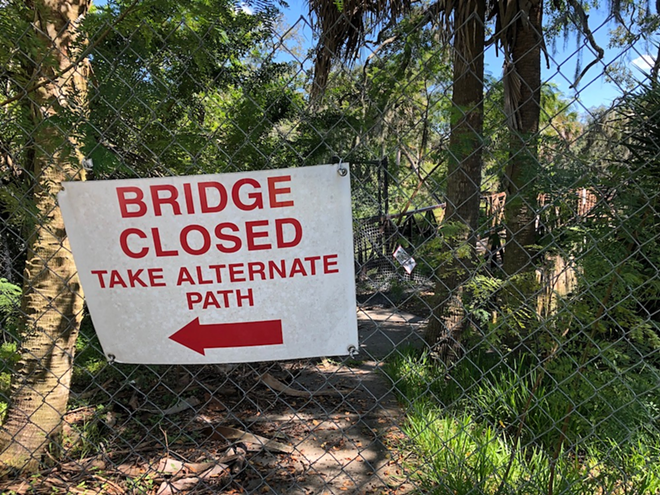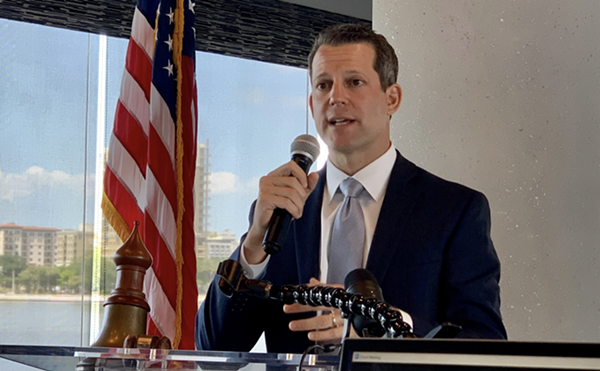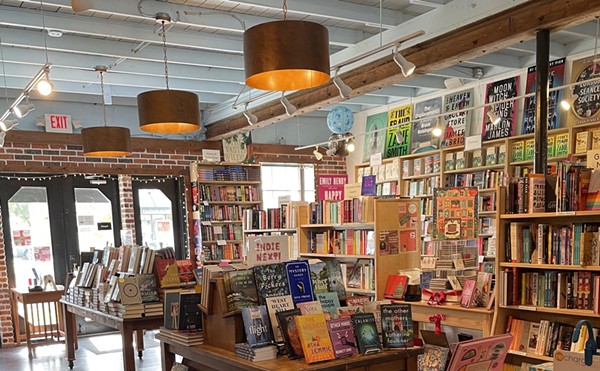Flying up I-275, heading north out of Tampa, it’s impossible to miss: the 200-foot Gothic Revival tower, pale as a ghost, glowering down from the west at the interstate below. It’s the iconic symbol of a leisure empire that had its heyday nearly a century ago: Sulphur Springs.
In the annals of Florida springs attractions, Sulphur Springs occupies a puzzling place. On one hand, it represents the epitome of our state’s celebrated tradition of springs tourism, a genuine Florida tourist trap from the boom years of the 1920s and a local hotspot well into the 1960s. But that history, so easy to see in the countless colorful postcards and photographs that remain, is almost entirely missing from the site itself (giant tower notwithstanding). Once heralded for the curative properties of its waters, the spring is now deemed unsafe for swimming (though still, during dry spells, tapped for the city’s water supply—after being treated, of course). And despite the fact that a tight knit community of neighbors has rallied around the springs for decades to advocate for its cultural and ecological value, the neighborhood is more often associated with poverty and crime than with its extraordinary contribution to Tampa history.
As I pull into the parking lot of the Sulphur Springs Pool off Nebraska Avenue one warm morning in early fall, lured by the lore of this legendary spring, these opposing images swap back and forth in my mind. What happened to Sulphur Springs? And what does it reflect about our ongoing reckoning with Florida’s water resources?
I head through the entrance gate to the sprawling pool, a chlorinated facility supplied by city water, which replaced its spring-fed counterpart after high bacteria counts shuttered it in 1986. When I tell the attendant that I’d like to bypass the pool and get a look at the spring, her eyebrows raise. “You know you can’t swim in it, right?”
She’s right to be suspicious; it’s hard to keep me out of the water. But the fact is, I couldn’t swim there even if I tried. The boil lies behind a tall chain-link fence, overshadowed by John Gurbacs’s mural depicting various species that can be found along the Hillsborough River. Outsized manatees and limpkins mingle with zoomed-in microscope views of the algae now so familiar in Florida springs. The water below pulses into a circular pool choked with what exploratory divers once described as “fluffy brown detritus” and “free-floating, jelly-like organisms”—which turned out to be pulverized plant matter and mats of hydrogen sulfide-eating bacteria. An old headline flashes through my mind: “Tampa’s Sulphur Springs too far gone, experts say.”
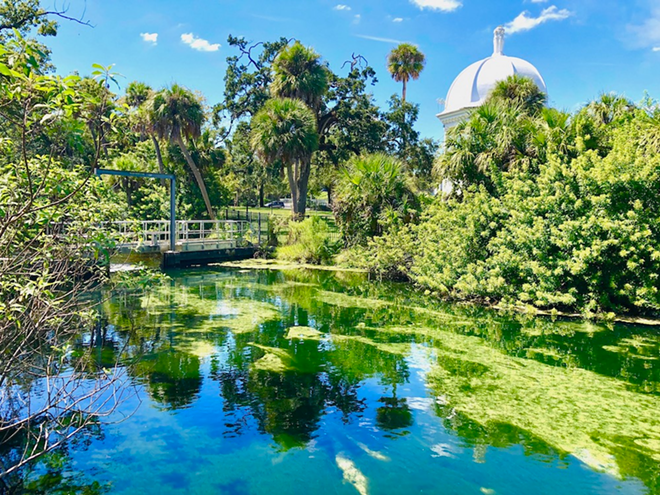
Multiple studies of the spring in the 1980s and 1990s demonstrated that the spring’s decline was linked to the degradation of about one dozen seeps and sinkholes in the neighborhood, some as far as two miles from the site, all hydrologically connected to the spring. With very little regulation around storm water management for most of the 20th century, these sites were subjected to decades of ecological abuses, including storm water retention, filling, and dumping. One dive into a sinkhole on Alaska Avenue in 1987 retrieved shopping carts, washing machine parts, furniture, and full bags of garbage—even the proverbial kitchen sink.
You could say that Sulphur Springs was, in this sense, the victim of progress and its legendary failure to foresee its own consequences: to recognize the reality that nothing we do in this wet sponge of a state stays out of the water table for long. With the spring’s pathways for recharge increasingly choked, paved over, or contaminated, and with less fresh water to push back saltwater flows edging in from below, Sulphur Springs has now changed in ways that would make it extraordinarily complicated and expensive to restore.
But the spring is not the only feature that has fallen off the map here: as I walk upstream along the river, I wind past an old gazebo where white tourists from all over the country—white tourists, because Sulphur Springs, like so many of our famous attractions, was segregated—once sampled the spring’s waters. I pass the bridge where they watched bathers sloshing down an enormous toboggan slide into the luminous blue spring run. Both are now fenced off. And so much more lies flattened under the massive parking lot around me: a host of delights—including a dance hall, an alligator farm, and a sandy bathing beach (sand trucked in, of course), and even Sulphur Springs’s legendary Arcade, still touted as “America’s first mini-mall.” All traces of these marvels disappeared when the land was sold to the dog track a few blocks north and converted to overflow parking in 1976.
Further on, where I-275 now cuts through the landscape, more stories lie buried. This area was once known as the Bottom, and it was one of the few places along the river where, during the era of Jim Crow, Black residents could enjoy access to the water. While the spring and its amenities were closed to them, says Dr. Antoinette T. Jackson, Director of USF’s Heritage Research Lab, Black residents turned to the river. “For Black people,” she reflects, “the river was their key place. It was an equalizer. Everyone could swim, fish, boat, and baptize in spite of segregation.”
Now this history, along with the 2-3 block wide strip of homes that the interstate claimed when it was built in the early 1970s, is concealed under a noisy, noxious, endless stream of motorized flow.
Now, at last, standing in the shadow of the River Tower, I can’t help but think that the familiar “march of progress” story does not explain what happened here.
With its major commercial center (the Arcade) demolished, a large section of its neighborhood uprooted by the interstate, and white flight taking many of its more prosperous families to other neighborhoods, the closure of the spring in 1986 struck Sulphur Springs at an already difficult time. In February of 1987, a group of neighborhood leaders known as the Sulphur Springs Action League applied to the Florida Department of Environmental Protection to obtain an Outstanding Florida Water designation for the spring, hoping its historical and ecological value might ensure future protection for this community asset. The request was stalled on the grounds that Sulphur Springs was not a pristine natural site and already had substantial pollution problems–not “outstanding” enough in the ways that counted.
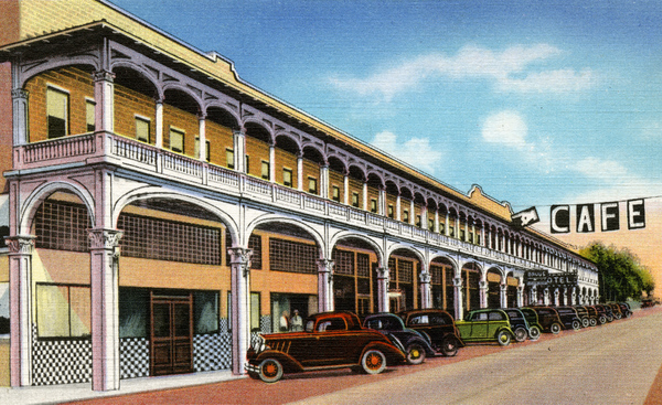
After years of organizing and multiple environmental studies, residents were able to secure the new, city-run pool, which fulfilled a major community need, especially in the summer months. Recent scholarship from USF’s Mathews Jackson Wakhungu has shown, however, that some basic needs such as updated sewer lines and effective drainage are still not being met in Sulphur Springs, and many residents drink bottled water out of mistrust for what comes out of the tap. When it comes to the community’s relationship to this most vital of resources, you might say the waters are still troubled.
When it emerged in the early 1980s, the environmental justice movement drew attention to the fact that marginalized communities often pay the highest price for industrial and urban development, while enjoying few of its benefits. Looked at through this lens, we could understand the loss of the springs as part and parcel of the neglect of an entire community—one whose voice was less often heard in the halls of power and whose unique history was, for too long, considered expendable. As Hillsborough County’s longtime official historian Theodore Lesley put it in 1976, when assessing whether or not to halt demolition of the Arcade: “From the boom time on, Sulphur Springs was nothing but a dive.”
But this is beginning to change. Tucked away on E River Cove Street, in a riverside park just a few blocks from the pool, is the Sulphur Springs Museum and Heritage Center. First conceived in 2006, the museum opened its doors in 2017, after a decade of collaboration between Sulphur Springs Neighborhood Association and USF’s Department of Anthropology. The museum tells the many-voiced story of Sulphur Springs and aims to provide empowerment for the community—especially for its younger residents. “We want them to be proud of the community in which they live, and also to help take care of the heritage, and to help it grow,” explained co-founder Norma Robinson in a 2017 interview. In addition to its own permanent exhibit on Sulphur Springs, the museum has featured traveling exhibits on the human ecology of water, civil rights in Florida, and, coming soon, the life and times of Frederick Douglass. A recent exhibit which showed the work of USF’s forensic anthropologists feels right in tune with this purpose: telling a fuller story of those people (and places) who have been lost helps us down the long path toward justice.
Behind the Museum is a small park with a lovely view of the Hillsborough. Perched in a small picnic area overlooking the river, it is easy to see how it might be, as Jackson says, a healing force. There’s peace in the steady drift of its tea-colored, tannin-dark waters, abundant life in its waters and in the green tangle of oaks, palmettos, and houseplants-run-wild that spills down its banks. Even the kayaks and canoes resting on the docks of riverside homes seem to lean out over the water, as if ready to drop in and go with the flow. Everything here tends toward the river.
And maybe that’s another answer to the question of what Sulphur Springs can teach us: the spring is only part of the story. More important is its connection to the river, the river’s connection to the bay, and our human connection to the entire life-sustaining system. Choosing to see those connections, rather than ignoring or denying them, is as fundamental to the work of justice as it is to the work of sustainability, which are, in the end, deeply entwined. And to do the work of sustainability and justice, we need to hear the whole story.
Send anonymous news tips to [email protected]. Support local journalism in these crazy days. Our small but mighty team works tirelessly to bring you news on how coronavirus is affecting Tampa and surrounding areas. Please consider making a one time or monthly donation to help support our staff. Every little bit helps.
Subscribe to our newsletter and follow @cl_tampabay on Twitter.


